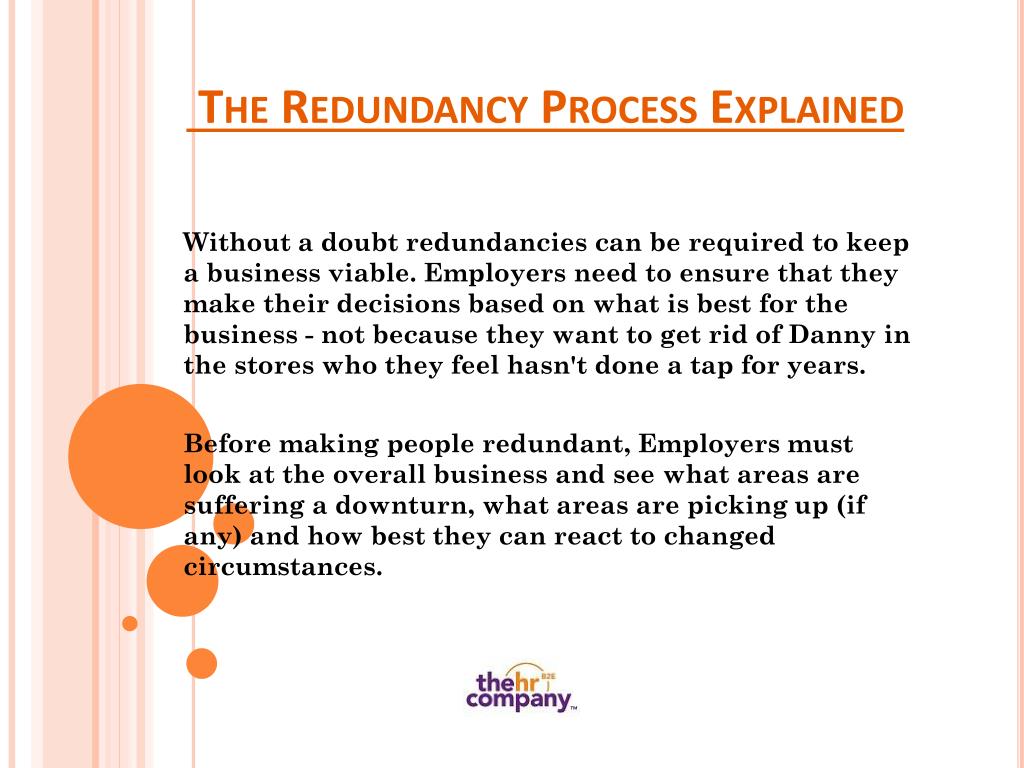Your Rights to Redundancy If Company Goes Bust: UK Employee Protections
Your Rights to Redundancy If Company Goes Bust: UK Employee Protections
Blog Article
Checking Out the Interplay In Between Business Redundancy and Organizational Flexibility for Future Development
In the dynamic landscape of today's service globe, the intricate relationship between business redundancy and business flexibility emerges as an important aspect for continual development and success. Companies frequently deal with the difficulty of striking a fragile equilibrium in between keeping a degree of redundancy to mitigate risks and fostering versatility to respond quickly to the ever-evolving market needs.
Relevance of Firm Redundancy
Firm redundancy is a crucial element that enhances organizational resilience and mitigates operational risks. By incorporating redundancy measures within the organizational structure, firms can much better hold up against unforeseen disturbances and variations in business setting. Redundancy offers as a critical barrier, enabling business to adapt and respond effectively to unanticipated obstacles without endangering necessary procedures.
One secret aspect of the significance of company redundancy is its role in ensuring connection throughout times of dilemma. When faced with sudden adjustments or emergency situations, redundant systems, resources, or personnel can tip in to maintain crucial features and avoid widespread disturbances. This connection not only safeguards the firm's track record and customer trust fund however also decreases monetary losses and functional downtime.

Methods for Business Flexibility

Creating versatile business structures that enable for quick adjustments to market characteristics and consumer requirements is necessary for remaining competitive in a rapidly advancing setting. By proactively recognizing prospective interruptions and opportunities, companies can proactively adjust and flourish in an ever-changing organization landscape.
Harmonizing Redundancy and Versatility
Attaining a harmonious balance in between operational redundancy and organizational flexibility is paramount in browsing the intricacies of a dynamic service setting. Striking the best equilibrium in between redundancy and versatility is a fragile website link process that needs a deep understanding of the company's goals, market characteristics, and risk tolerance.
To achieve this balance, firms require to conduct routine analyses of their procedures to recognize areas where redundancy is required for threat reduction and where adaptability can drive development and growth. Carrying out flexible structures, promoting a society of continuous knowing and renovation, and encouraging open interaction throughout all degrees of the organization are essential techniques to balance redundancy and adaptability effectively. By aligning these two crucial elements, companies can position themselves for sustainable development and success in an ever-changing organization landscape.
Study on Adjustment Success
In checking out circumstances of successful organizational adaptation, it comes to be noticeable that the interaction between operational redundancy and flexibility is a specifying element in shaping resistant organizations. One compelling Home Page case research is that of Netflix. At first a DVD rental service, Netflix demonstrated impressive versatility by transitioning right into a streaming system when digitalization disrupted the sector. By tactically buying modern technology and material production, Netflix not only grew however endured in a quickly evolving market. One more standout example is Amazon. Beginning as an on the internet book shop, Amazon continuously adjusted its company version, expanding right into diverse fields such as cloud computing and man-made intelligence. This versatility allowed Amazon to remain ahead of competitors and fulfill changing customer needs. Lastly, Adobe supplies a noteworthy picture of effective adaptation. The business changed from selling software application licenses to a subscription-based version, ensuring persisting earnings streams and enhanced client involvement. These study emphasize the significance of operational redundancy paired with organizational adaptability in promoting lasting growth and competitiveness.
Structure Durability for Future Development
Structure resilience for future development needs a strategic placement of operational procedures with market dynamics and arising patterns. Firms need to adapt to altering environments by cultivating a culture of adaptability, development, and continual enhancement.
In addition, promoting solid connections with stakeholders, such as consumers, employees, distributors, and the neighborhood, is essential for weathering unpredictabilities and maintaining count on and assistance during unstable times. Effective communication and openness play a vital function in structure resilience, as they assist facilitate and align assumptions cooperation in navigating uncertainties.
Moreover, companies need to prioritize discovering and development efforts to upskill staff members and outfit them with the required devices to adjust to transforming circumstances. By investing in their labor force, firms can boost their flexibility and agility, ultimately enhancing their strength for lasting future development.
Conclusion

In the vibrant landscape of today's service world, the detailed relationship in between company redundancy and organizational flexibility emerges as a critical element for continual development and success. Companies commonly face the difficulty of striking a fragile equilibrium between preserving a degree of redundancy to mitigate dangers and promoting flexibility to helpful resources respond swiftly to the ever-evolving market needs.To attain this equilibrium, companies need to carry out normal analyses of their operations to identify areas where redundancy is needed for threat reduction and where adaptability can drive development and growth.In final thought, the interaction in between firm redundancy and organizational adaptability is essential for future growth. Structure durability via a mix of redundancy and flexibility will certainly ensure that companies are prepared for the challenges of the future.
Report this page